|
The Mirage F1 came about when plans for
the successor to the Mirage III proved too expensive and unpopular to
the French Air Force. It was a time when new technologies were being
tested including vertical take-off and swing-wing concepts. Dassault
developed the F1 as a private venture to offer a cheaper multi-role
aircraft. From the outset it was designed to obtain the best operational
efficiency and the widest flexibility. The idea being that even a small
fleet of these aircraft should represent an important military threat.
Something which was proven later in Angola! It was to be able to operate
from short rough strips which the twin pulled wheel on the main gear
together with medium pressure tyres plus low landing speed (145 kts)
enabled it to do. It provided minimum and fully air transportable ground
handling equipment together with a self starting system. It provided
a short turn around time of about 15 minutes between two identical missions
together with pressure refueling of about six minutes. An engine change
involving four men took about three hours The SDAP automatic testing
unit enabled automatic trouble shooting in the field. The GAMO alert
unit allowed the Mirage F1 to be scrambled in less than 2 minutes. Thus
it was to prove an ideal 'Bush' warfare aircraft capable of operating
for extended periods away from itís home base, as was the case for the
SAAF operating in Namibia.
The Mirage F1C prototype made itís first
flight on the 23rd of December,1966. During September 1967, the French
Air Force expressed interest on the Mirage F1C as an all weather interceptor.
This was adequately provided by the use of the Cyrano IV radar. The
second prototype F1-02 first flew on the 20th March,1967 and the third
prototype F1-03 flew on the 18th of September,1969. On the 17th June
1974, the final prototype F1-04 flew and this became the production
version. This was to become the first Mirage F1 ever flown by a South
African when Zach Repsold flew it on 6 October 1971. This differed from
the others by using slotted slats. On the 14th March 1974, the French
Air Force received the first Mirage F1. The French Air Force Mirage
F1C first saw combat during operation Manta in August 1983. This was
when they were used for strafing an enemy column.

First Prototype Mirage F1, Saint Cloud 23 December 1966. Photo: Keystone Press Agency / P. Dubois collection |

First prototype aircraft. Photo: Dassault Aviation /
P. Dubois collection |
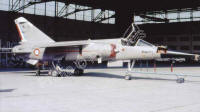
Second prototype aircraft. Photo: P. Dubois collection. |
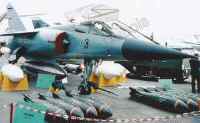
Third prototype aircraft, Le Bourget 29 May 1973.
Photo: P. Dubois Collection. |
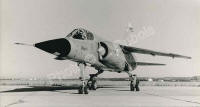
First pre-production aircraft. Photo: Dassault Aviation /P. Dubois collection |
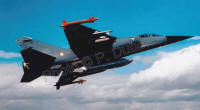
Fourth prototype and first production F1. This
particular aircraft was also the first Mirage F1 to be flown
by a South African. Photo: Dassault Aviation |
In July 1973, in what was to be known
as the deal of the century, Dassault tended the Mirage F1E or the Mirage
M53 as it was later to be known as a contender for the new European
fighter aircraft required by Belgium, Denmark, Netherlands and Norway.
To meet this requirement, the Mirage F1 was equipped with more sophisticated
avionics and a more powerful engine, the M53 engine. This engine is
shorter than the standard ATAR 9K50 and required larger air intakes
and a shorter rear fuselage. Unfortunately, this lucrative deal was
won by the American F-16.
In 1971, South Africa began looking for
a replacement for the Mirage III . The Mirage F1 was an improvement
of the Mirage III in that it has an increased speed, increase pursuit
flight time an high mach which was tripled , and a ground mission range
doubled, Take off length 30% less, with 25% less approach speed and
increased maneuverability. On the 27th June 1971, Dassault and SNECMA
announced a technical cooperation agreement with South Africa for the
license manufacture of the Mirage F1 and engine. The intention being
to produce up to 100 Mirage F1ís.

SNECMA ATAR 9K 50/ Photo: Dassault Aviation |

Mirage F1-E fitted with a SNECMA M53
engine. Photo: Dassault Aviation /
P. Dubois collection |
The 1977 arms embargo caused this license
to lapse and unfortunately the Atlas Mirage Program did not move beyond
the assembly stage. The South African Air Force acquired 16 Mirage F1-CZís
(Serial 200-215) and 32 Mirage F1-AZís Serial 216-247). Mirage F1-CZ
'200' was the main project aircraft, whilst Mirage F1-AZ '216' was used
as the project aircraft for the 'AZ' fit. Due to the approaching Arms
Embargo, Dassault rushed the F1-AZ delivery which not only led to teething
problems with this ground attack variant but also caused problems with
the manning of the Mirage III fleet which was later overcome by Operation
Sand which enabled the Rhodesians to maintain the Mirage III CZ fleet.

Mirage F1-CZ '200' salvo drop of eight 400kg bombs, during acceptance
trials in France. Photo: Dassault Aviation Film footage. |

Mirage F1-CZ '200' salvo firing of
Matra 68mm rockets, during acceptance trials in France, 1975.
Photo: Dassault Aviation. |

Mirage F1-CZ '200' at the Paris Air Show 6 June 1975.
Photo: P. Dubois Collection. |
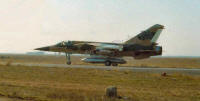
Mirage F1-CZ '200' seen at Istres 1974 during acceptance trials.
Photo: P. Dubois collection. |

Mirage F1-AZ '216' during acceptance trials in France 1975.
Photo: Peter Greve/P.Dubois collection. |
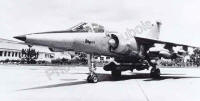
Mirage F1-AZ "216" with the 14 bomb configuration during acceptance
trials in France. Note the camera's fitted directly below the
cockpit. which recorded the bomb release. Photo: Dassault Aviation/P.
Dubois collection. |
Delivery began under great secrecy on
4 April 1975 when two Mirage F1-CZís were flown to South Africa in a
SAAF C-130 Hercules. Delivery ended in October 1976. South Africa maintained
great secrecy over this aircraft and only revealed a new 'Mirage-type'
during a fly past at the Ysterplaat Air Show in October 1975. It was
only in April 1977 that the press could visit the production line in
Kempton Park and even then the Mirage F1-AZ remained classified until
1980.
THE MIRAGE F1-CZ
South Africa was the launch foreign customer
for the Mirage F1-C with the test aircraft for this project being Mirage
serial '200' and whilst still being kept secret from the South African
public, this aircraft appeared in several publications such as 'Paris
Match' and it was also used as a display aircraft at the Paris Air Show
1975.
On the 4 April 1975, 3 Squadron became an autonomous unit once more
with the arrival of Mirage F1-CZís serial 204 and 205 from the Atlas
Aircraft assembly line at the then Jan Smuts Airport. The rest following
at intervals until 1977 when Mirage F1-CZ serial '200' finally joined
the fleet, thus completing the order for 16 aircraft. Serials 200-215.
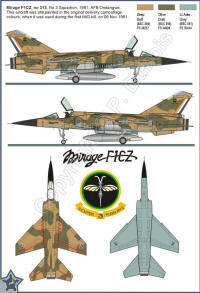 |
Mirage F1-CZ, No 213, No 3 Squadron, 1981, AFB Ondangwa.
This aircraft was still painted in the original delivery camouflage
colours
when it was used during the first MIG kill, on 6th November
1981.
Diagram by William S Marshall. |
All aircraft were delivered in an olive
drab/ deep buff scheme with blue/white springbok castle insignia. The
squadron emblem being applied in South Africa. During the early eighties
the scheme was changed to an air superiority blue/grey scheme with false
canopy painted on the underside. The insignia was sprayed over to make
it low viz. The first Mirage F1-CZ to receive this scheme was '203'.
The SAAF Mirage F1-CZ wasted no time
getting operational and on the 3 November 1978, five Mirage F1-CZís
were deployed to AFB Ondangwa in SWA/Namibia tasked with providing escort
for reconnaissance flights over Southern Angola. From 1980 these deployments
became regular with operations such as 'Smokeshell'. The tasking was
normally as escort aircraft but due to teething problems with the Mirage
F1-AZ, it was soon tasked with pre-emptive strikes against the enemy
using Matra M155 rocket pods or 250 kg bombs.
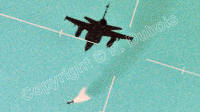
A Cinethoeodolite image of Des Barker firing a V3C missile at
a high speed drone. Photo: OTB/P.Dubois collection. |

Mirage F1-CZ drone kill, Pilot Des Barker.
Photo: P. Dubois/TFDC. |
On the morning of the 6th November 1981
the Mirage F1-CZ got itís first test as an interceptor. Two Mirage F1-CZís
flown by Major JJ Rankin and Lt. J du Plessis were scrambled from AFB
Ondangwa to intercept two MiG-21MFís. Lt. du Plessis tried twice to
engage one of the MiG-21MFís but on both occasions his missiles failed
to engage. Major Rankin flying Mirage F1-CZ '213' could also not
lock his missile due to the proximity of the sun but opened fire with
his 30mm DEFA cannons which caused Lt. Danacio Valdezís MiG-21MF to
explode and was seen to break in half. Lt. Valdez was seen to eject
but did not survive. This was the first confirmed SAAF kill since the
Korean War.
|

|
Mirage F1-CZ's first kill.
Photo: SAAF/P. Dubois collection.
|
During the afternoon of 13 May 1982 the
F1-CZís bagged their second kill. This was the Angolan Mil Mi-8 helicopter
serialed either H-516 or H-518 which was believed to be carrying senior
officers. Captain M Louw flying Mirage F1-CZ '206' and Lt. Jon Inges
flying '210' were tasked with locating and destroying the helicopter
in the Cuvelai area. The helicopter was located with rotors running
on the ground. Lt. Inges attacked first but was off target. Captain
Louw then followed, destroying the helicopter in a hail of 30mm fire.

Mirage F1-CZ's second kill.
Photo: SAAF/P. Dubois collection. |
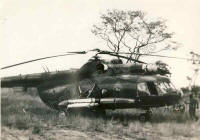
Angolan Mil Mi-8. Photo: SAAF/P. Dubois collection |
Events on the 5th October 1982 are not
so clear and much controversy remains over what actually happened. There
is also much contradiction amongst Cuban and South African sources.
The author has done much research on this and Iíve tried to piece together
what happened based on the information available. It is of course entirely
up to the reader to choose what they want to believe. Due to the harsh
restrictions of Cuban authorities and Johan Rankinís reluctance to discuss
the matter Iíve had to rely almost solely on written statements by the
parties involved, with the noted exception of the excellent feedback
from Cobus Toerien and the detail given by Barbaro Perez Duran. Some
information may have also been lost//misinterpreted in the translation
from the original Cuban text. Whatever happened that day, both parties
agree that at least one MiG-21bis was written off. The South Africanís
providing convincing gun-camera footage of the MiG-21bis exploding,
albeit a clean explosion without debris as if a fuel explosion. That
said it should be noted that no sane pilot would remain with his aircraft
after such an explosion especially when considering that Lt. Raciel
Marrero Rodriguez was a Third Class Pilot with only 320 flying hours!
Surely he would have ejected, wouldnít you? Also they had been flying
with full burner for six minutes, did Lt. Rodriguez have sufficient
fuel to make it back to Lubango? Cuban sources insist that he returned
to Lubango were witnesses said that the aircraft looked like a sieve
from all the projectile holes ripped into it. The remains of such a
MiG were seen at Lubango during the nineties.
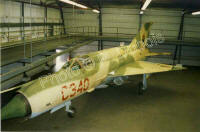 |
Angolan
MiG-21bis. Photo: Paul Dubois. |
During this period the Radar at Cahama
was experiencing many difficulties and most of the MiG-21ís were scrambled
to false alarms and thus the more experienced pilots tended to bully
the younger pilots into doing these alerts. On this occasion it was
for real. At 10h28 am SAAF aircraft had been detected between Virey
and Tchibemba (The Mirage F1-CZís) and a second pair heading for Cahama.
(The Canberra or Canberraís depending which version you wish to follow.)
This was the Reconnaissance Canberra from 12 Squadron flown by Cmdt.
Bertus Burger and navigator Maj Swanepoel tasked with a photo-reconnaissance
of Cahama, together with one other? (Where two Canberraís involved?)
Their escort was two Mirage F1-CZís from 3 Squadron, flown by Maj. Johan
Rankin and his wingman Capt. Cobus Toerien. Maj. Rankin was flying Mirage
F1-CZ '203' which was nicknamed 'Le Spectre' as it had the new air superiority
blue/grey scheme, whilst the other Mirage still had the old scheme.
The Mirage escort was late due to Capt Toerien having problems starting
his Mirage and it is possible that this led the Angolanís to believe
that the Canberra was unescorted.
At approximately 10h42 am Lt. Raciel
Marrero Rodriguez, call sign 846 and Lieutenant Gilberto Ortiz Perez,
call sign 324 got airborne. Lt. Barbaro Perez Duran was the GCI controller
(Leon 5) and he directed them to the Cahama region. At this point the
South African Dayton Radar picked them up and the controller Captain
Les Lomberg instructed the Canberra to head south whilst vectoring the
Mirage F1-CZís north climbing to 30 000ft. At this point two other MiG-21ís
where placed on standby at Lubango. When Lt. Duran advised the MiG-21ís
that the target was 10 kmís away they jettisoned their auxiliary tanks.
Major Rankin picked up the two MiG-21ís 5nm away and at the same level
to his right. The Mirageís then jettisoned their auxiliary tanks and
went into afterburner whilst making a hard right hand turn. Lt. Perez
visually located the Mirages when they released their auxiliary tanks
and then the MiG-21ís also turned right with maximum turn.
As the Mirage F1ís began maneuvering
the MiG-21 pilotís lost visual with the Mirage F1ís. The MiG-21 began
a new turn whilst searching. At the crucial cross they flew so close
that Captain Toerien could see Lt. Rodriguez helmet and in fact they
almost flew into each other. At that point Lt. Rodriguez was looking
downward. Two minutes after having lost sight of the Mirageís, Lt. Perez
looked through his periscope and saw Maj. Rankin between 800 and 1000
metres behind him. He advised Lt. Rodriguez, did an abrupt semi reversal
and leveled out. Major Rankin fired two Matra 550 missiles at Lt. Perez,
one at 3000m and the other at 1500m, whilst doing in the region of Mach
1.2 at 30 000 amsl. The first being fired on the edge of the missiles
parameter and this failed after the motor burnt out. The second missile
was fired in the heart of the envelope, almost too close for the height
and speed and exploded immediately behind Lt. Perezís MiG-21. Lt. Perez
was seen to dive towards Lubango trailing smoke. He had not felt the
impact to the right stabilizer and therefore did not realize that he
had been hit. His MiG-21bis serial C-47 landed at Lubango without difficulty.
During the combat his aircraft had pulled a maximum of 6 Gís.
At this point two more MiG-21ís were scrambled but failed to locate
the Mirageís once in the area., returning once they were low on fuel.
Did Cuban witnesses mistake these two for the original MiG-21ís scrambled
thus believing that they had safely returned?
When Lt. Rodriguezís located the Mirageís they were directly in front
of him and at the same time he noticed a very bright explosion to his
left. He noticed the two Mirageís separate with one going up and the
other to the left, his right, and before losing sight of them he noticed
them turning to the right. At this he kept turning right at maximum
speed, whilst trying to communicate with the GCI controller. When he
finally got through, Lt. Duran ordered him descend to 2000 metres at
270 degreeís and to search that area. At this point Capt Toerien had
caught up with Maj. Rankin. The new low viz scheme on Maj. Rankins Mirage
started to pay dividends! Lt. Rodriguez was attacked by Maj. Rankin
at around 500metres but he could only detected Capt Toerien's Mirage
in his periscope at around 1800 metres and he thought the 30mm Cannon
fire was coming from 1800metres. Lt. Rodriguez was turning hard at about
60-70 degreeís when he realized that Maj Rankin had entered his turn
radius.
Due to the vertical form of his left
wing, the wing became perforated and he also felt the impact from his
tail being hit with a momentary increase of speed. At this point he
advised Lt. Duran that he had been hit and was descending. Lt. Rodriguez
claims that he still had control of the aircraft although flames were
shooting from the tail and he was trailing black smoke. All hydraulics
and oil pressures were normal, the only difference was a tendency for
the aircraft to bank right. When about 45kmís away from Lubango he advised
control that he was worried that the damage to his left wing was going
to interfere with the lowering of his undercarriage. (This fitís with
the radio messages picked up by South African forces and attributed
to Lt. Perezís MiG-21.) Lt. Rodriguez claims to have landed safely.
His aircraft having pulled a maximum of 6.7 Gís during the combat. Major
Rankin had tried to fire at 350m but had pushed the trigger safety guard
back by mistake.
After clearing the guard and firing he
was down to 230m. The fuel started leaking from the MiG-21 and then
exploded, Major Rankin flew through the fire ball, causing a compressor
stall. He then cut the engine and did a hot relight before heading towards
Ondangwa. Capt. Toerien had followed the MiG-21 which had turned right
(Northwards) whilst rapidly descending trailing a large plume of black
smoke from the left rear of the fuselage, but he turned back once Maj
Rankin reported his compressor stall. At this point Capt. Toerien had
lost sight of Maj. Rankin and was concerned about the other MiG-21ís
which the South African radar had now picked up. Maj. Rankin then climbed
past him at his right abeam position before both returned to Ondangwa
on minimaís. The air combat had lasted around six minutes.
The Cuban pilots used rigid doctrine which did not allow for individual
initiative, always under the control of the GCI Controller, thus no
matter their experience, their tacticís always remained the same. Due
to this disastrous attempt at intercepting the South Africanís, Colonel
Bilardel, OC Lubango was removed from his post and demoted.
Like every year, the Bush War saw an escalation and by 1987 it was heading
for conventional war status. From 1987 the Cubans deployed two MiG-23ML
units to Angola forming 12th and 13th Squadrons of the FAPA-DAA, part
of the 25th Air Combat Regiment. Some fifty MiG-23MLís were supplied
direct from the USSR. Up until this point the Angolan Air Force had
chosen to avoid the SAAF but now the Cubans goal was to challenge the
SAAF air superiority over the battle fields. The main base was at Menongue
which was heavily defended against air attack. It is clear that the
Cubans plan was to start a war of attrition, something that due to the
Arms Embargo the SAAF was never going to win. By the end of 1987 the
Cubans had added another 30 MiG-23MLís
to the Angolan fleet.
The SAAF met this threat by deploying Mirage F1-CZís to Rundu AFB in
the Eastern Caprivi. They also started upgrading this facility, something
they should have done earlier, as events were to prove. The MiG-23ML
crews preferred to use their superior speed for slash and dash type
attacks on the SAAF, whilst the SAAF preferred to 'mix' it with the
enemy. On the 10th September 1987 a Mirage F1-CZ fired an R.550 missile
at a MiG-23ML but without results. Events took a dramatic change on
the afternoon of 27th September 1988, when four Mirage F1-CZís where
scrambled from Rundu to intercept a pair of MiG-23MLís flown by Maj.
Alberto Ley Rivas and Lt. Juan Carlos Chavez Godoy who were providing
CAP for some helicopters. Capt. Arthur Piercy in Mirage F1-CZ '206'
was wingman to Cmdt. Carlo Gagiano and it was this aircraft that Maj.
Rivas saw during the initial engagement. The Mirage F1-CZ was in front
of him but slightly higher. Maj. Rivas fired one missile. (According
to South African sources an AA-8 missile.) Capt. Piercy saw the bright
flash as two missiles were fired from the frontal sector, one passing
over Cmdt. Gagianoís aircraft, the other exploded alongside Capt. Piercyís
Mirageís tail section, this was followed by Maj. Rivasís MiG flashing
past.
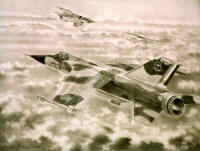
A Pencil
sketch by artist Geoff Pleasance depicting the attack by
Maj. Alberto Ley Rivas against Capt. Arthur Piercy. |

Angolan 'Vet', MiG-23ML '223' seen at the DAAFAR Museum, Havana.
Photo: Paul Dubois. |

MiG-23ML '223' with star indicating a successful mission in
Angola/ DAAFAR Museum, Havana. Photo: Paul Dubois. |
Capt. Piercy states that the combat lasted
about 40 seconds. His aircraft plummeted earthward before he was able
to recover it. He returned to Rundu AFB at extreme low level when the
electric pump, right side fuel pump and hydraulic H-2 system failed.
He also had no drag- chute as this had been damaged in the missile blast.
The aircraft came down fast on the 2000m runway, overshot and went through
a perimeter fence before the nose wheel struck a rock causing the seat
to eject. The parachute had no time to open which resulted in serious
injuries to Capt. Arthur Piercy. Mirage F1-CZ '206' was written off
but parts were used later to rebuild Mirage F1-CZ '205' which had been
damaged in a fire.
The superior speed of the MiG-23ML , with there frontal aspect air-to-air
capability, coupled with the very poor performance of the South African
air-to-air missiles meant that the SAAF could no longer afford to risk
itís precious few Mirage F1ís in air to air combat. This severely limited
their daylight operations. The Mirage F1 remained a threat to the MiG-23
and as long as the SAAF retained the numbers they would act as a deterrent,
thus the SAAF needed to avoid a war of attrition.
Claims have even been made by authors such as Timothy Good about two
Mirage F1-CZís dueling with UFOís near Ludoritz (Namibia) on 18 June
1977. Even though no Mirage F1-CZís had been deployed to Namibia at
that stage, nor had any been lost during 1977.
During almost ten years of continuous combat, the SAAF only lost one
Mirage F1-CZ to enemy action. A further three were lost in accidents
and one ('214') was broken up in 1992 as part of an engine upgrade program.
The aircraft lost where;
'200' w/o on 15 February 1979 after the aircraft stalled.
'206' aircraft damaged severely due enemy action.
'208' w/o on 4th November 1980 after mechanical failure, pilot ejected.
The Mirage F1-CZ was withdrawn from service on 9th September 1993 when
3 Squadron was disband, however Mirageís '205' and '209' continued to
operate as part of 190 Squadron until 1993. These aircraft were used
for the clearance trials of various missiles.
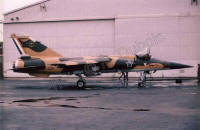
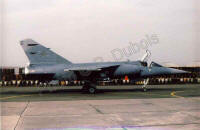 |
Mirage F1-CZ
'209' showing the two different schemes worn by the Mirage F1-CZ.
Photo: P. Dubois collection. |
THE MIRAGE F1-AZ
The Mirage F1-AZ is probably better known in the UK for the black painted
jet in the French car manufacturer commercial which was shown on TV.
The Mirage F1-AZ is optimised for ground attack and was designed to
meet a South African requirement. Due to the 1977 arms embargo this
project was rushed before all the 'gremlins' in the ground attack suite
had been resolved, this caused a few initial problems in South Africa.
The first Mirage F1-AZís to arrive in South Africa, came by sea during
March 1976 and were assembled at Atlas Aircraft near Johannesburg. Thirty-two
Mirage F1-AZís (Serial 216-247) were delivered from November 1975 until
October 1976.
All Mirage F1-AZís went to 1 Squadron
at Waterkloof AFB before finding a permanent base at the ultra modern
Hoedspruit AFB. The first aircraft '216' was the project aircraft and
Cmdt. Piet Huyser was the South African project officer for this aircraft.
He was responsible for the cockpit layout. Two 'dummy' Mirage F1-AZís
were given the serials '248' and '249', these were used as decoy aircraft.
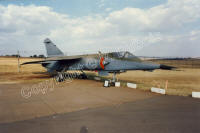 |
Mirage F1-AZ
decoy.
Photo: Paul Dubois. |
Whilst the local South African magazine,
'Scope' covered the Mirage F1 in their edition on 29 July 1977, it was
only in 1980 that the South African public became aware of the existence
of the Mirage F1-AZ and even then itís air-to-air refueling capability
was kept secret. Not only was the Mirage F1-AZ a South African concept
but they also funded the design and development of the roller map and
nav/weapon system. The fundamental difference between the Mirage F1-CZ
and AZ variants is the removal of the expensive Cyrano IV radar, being
replaced with the smaller ESD AIDA 2 target ranging radar. The AIDA
radar still gave secondary air-to-air capability. Of greater value to
the SAAF, especially during the later years was the additional fuel
capacity coupled with the retractable air-to-air refueling probe.
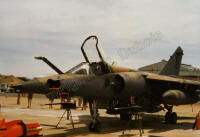 |
Picture showing the retractable refueling probe.
Photo: P. Dubois |
The extra fuel being provided by an additional
fuel tank behind the cockpit. The ground attack suite consisted of the
Doppler effect ESD Navigation system, Thomson CSF laser sighting, SFIM
inertial control unit, Thomson CSF 129 HUD, moving map display and two
Crouzet/Thompson computers. This system enabled a target to be located
from 3 miles for an automatic bomb release.
Maj. Gawie Winterbach flew the first Mirage F1-AZ acceptance flight
in Mirage F1-AZ '216' on 7 October 1975 and again on the 24 March 1976
when he became the first to fly a Mirage F1-AZ in South Africa. The
Mirage F1-AZ began in-flight refueling from Buccaneer aircraft on 23
August1976 and from 1986 they also used Boeing 707 tanker aircraft.
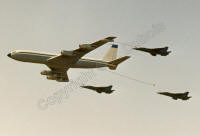 |
Mirage F1-AZ's
refuelling from a Boeing 707 tanker.
Photo: P. Dubois |
On the 6th July 1978 the Mirage F1-AZ
carried out itís first operational sortie from MíPacha AFB and the last
was flown from Grootfontein AFB on 23 March 1988.
During the last seven months of the war 683 combat sorties were flown,
delivering 3068 bombs. It is estimated that over this period more than
100 SAMís had been fired at them. The SAM was the greatest threat faced
by the Mirage F1-AZ, with Mirage F1-AZ ď245Ē being shot down by a SA-13
missile. Mirage F1-AZís ď237Ē and ď234Ē had a lucky escape during 1980
after being hit by SA-3 missiles. Capt. Du Plessis received the Honoris
Crux for saving his valuable aircraft. To counter this ever increasingly
sophisticated SAM/AAA/Radar network not only were the tacticís changed
but aircraft were also upgraded. The original BF radar detector was
replaced with the Radar and Infra-red Misleading System better known
as RIMS. This system consisted of a junction box fitted to the rear
port fuselage and a dispensing pod located under each wing on station
zero.
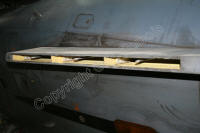
RIMS Chaff. Photo © D. Coombe |
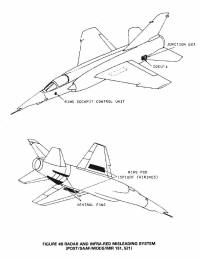
Diagram of RIMS/ Atlas Aircraft |
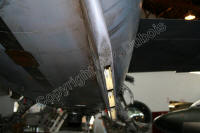
RIMS Chaff. Photo © D. Coombe |
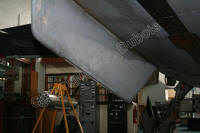
RIMS Chaff. Photo © D. Coombe |
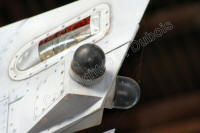
RIMS on tail, known as the 'cats balls'. Photo © D. Coombe |
This was not popular with the pilots
because it created a tremendous amount of drag. The under fuselage keels
were replaced with larger ones which held flare/chaff dispensers inside.
This system was fitted to both Mirage F1 types. Some Mirage F1-AZís
carried an ELT/555 (V)3 jamming pod under the port wing. Added to this
the Mirage F1-AZ crews changed tacticís to use the long toss bombing
profile or Vergooi as the SAAF called it. This involved pulling up the
aircraft around 4nm from the target and literally ďtossingĒ the bombs
towards the target. The aircraft also received a new camouflage. Whilst
various schemes were used, the final scheme was with all upper surfaces
retaining the olive drab and dark earth camouflage and all under surfaces
and sides being blue/grey.
 |
ELT/555 (V)3 jamming pod. Photo: Electronica/ P.Dubois collection |
The Mirage F1-AZ also proved to be a
very useful interceptor. On the 8th July 1981, Lt. Adriano Francisco
Bomba of the Mozambique AF flew his MiG-17, serial '21' from his base
near Maputo and defected towards South Africa. Two Mirage F1-AZís flown
by Maj. F Pretorius and Capt. H Louw were returning from a training
exercise when they got diverted to Intercept the MiG-17. The MiG-17
was 40km inside South Africa when intercepted. After exchanging hand
signals Lt. Bomba was forced to land at Hoedspruit AFB. After much evaluation
the MiG-17 was returned by road to Mozambique.
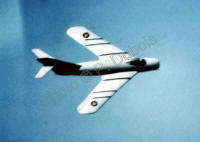 |
Mozambican
MiG-17 being tested by Cmdt Bob Mason SAAF.
Photo: P. Dubois Collection. |
Then again on the 31 March 1981, two Mirage F1-AZís intercepted a Zimbabwean
AF CASA 212 and forced it to land at Hoedspruit AFB after asserting
that the aircraft had 'strayed' into South African airspace, it was
allowed to continue to Zimbabwe.
On the 25th February 1987 three Mirage F1-AZís fired several V-3B missiles
at a group of Angolan MiG-23MLís without success. This was repeated
again on 25th February 1988 when South Africaís ace (Rankin) tried his
luck again, this time in a Mirage F1-AZ.
He fired a missile at an Angolan MiG-23ML and even tried his 30mm canon
again but this time without success. Various other unsuccessful attempts
were made during the 1987-88 period. Mirage F1-AZ '220' even received
the same grey/blue air superiority scheme as used by the Mirage F1-CZ.
On the 30th July 1994, four Mirage F1-AZís escorted President Mitterrandís
Boeing 747 into Cape Town.
After the war, plans were made to upgrade the Mirage F1 fleet by replacing
the Snecma Atar 09K50 engine with the SMR95 engine which was based on
the Klimov RD-33, and the integration of the Russian R-73 air-to-air
missile. Fittingly the project aircraft for this was once again Mirage
F1-AZ '216'. Mirage '216' became known as 'Super Mirage F1'. Echoing
events of 1973 with the Mirage M53, sadly this project came to an end
when after 22 years of service the SAAF withdrew the Mirage F1-AZ from
service on the 25th November 1997. Thus ending the SAAFís 35 year association
with Mirage aircraft.

South Africa's 'Super' Mirage F1
with SMR-95 engine.
Photo: P.Dubois Collection. |
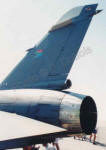
Closer view of Super Mirage F1 engine. Photo: P. Dubois. |
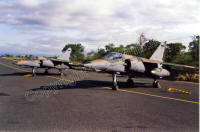
Last day of F1-AZ in service. Photo: Paul Dubois. |
Another project involved fitting an advanced
avionics suite to Mirage F1-AZ '235', this system was introduced to
the Spanish AF Mirage F1ís. Mirage '235' was given the unique white
and arctic blue scheme, earning it the nickname as the worlds fastest
dairy cart.
After 22 years of service, only eight Mirage F1-AZís were lost, one
due to enemy action.
Those lost were:-
'221' w/o 5th February 1992 after a bird strike, pilot ejected.
'222' w/o 4th April 1985, pilot ejected.
'223' w/o 19th March 1988, aircraft flew into the ground when returning
from Angola.
'224' w/o 9th June 1993 after aircraft ingestion of shrapnel during
bombing exercise, pilot ejected.
'228' w/o 13th February 1984, pilot got disoriented in bad weather and
ejected.
'234' w/o 23rd November 1993 when aircraft flew into the sea during
a low level maritime strike exercise.
'234' Pilot ejected but lost at sea.
'245' Shot down by SA-13 missile, pilot was killed.
'246' w/o 15th February 1979 after engine failure, pilot ejected. This
was the first Mirage F1 lost by the SAAF.
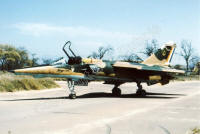
Mirage F1-AZ '245' shot down by a SA-13 missile. Photo: P.Dubois
Collection. |
|
Of the 24 remaining aircraft, 22 were
offered for sale in 1997 and in 2002 Aerosud purchased them with the
intention of returning 18 of them to service. So far they have sold
eight aircraft to the Gabonese Air Force.
Those known to have been delivered are:-
'239' which went to Gabon in August 2006 as TR-KML with about 1450 airframe
hours.
'241' which went to Gabon in August 2006 as TR-KMM with about 1544 airframe
hours.
'236' which went to Gabon in November 2007 as TR-KMN with about 1406
airframe hours.
'244' which went to Gabon in November 2007 as TR-KMO with about 1591
airframe hours.
This aircraft was one of the last two aircraft
to receive a service at Atlas Aircraft just months before retirement.
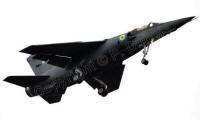
Gabon Mirage F1-AZ ex '239'. Photo: Cobus Coetzee. |
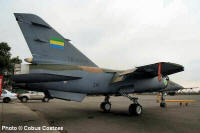
Gabon Mirage F1-AZ ex '241'. Photo: Cobus Coetzee. |
GENERAL PHOTOS
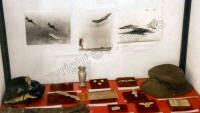
The pitiful 'Angolan War' display
at the DAAFAR Museum in Havana.
Photo: P. Dubois. |
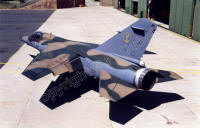
Mirage F1-AZ '227'. Photo: P. Dubois. |
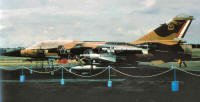
Mirage F1-CZ '212'. Photo P. Dubois Collection |
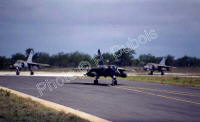
Mirage F1-AZ's taxi back for the last time, on 25 November
1997, end of an era. Photo: P. Dubois |
| |
|
By Paul Dubois
With thanks to: Luc Berger,
Des Barker, Cobus Toerien, Johan Rankin, Rubťn Urribarres, SAAF, TFDC,
DAAFAR Museum, Dassault Aviation and the many other people who assisted
me with this article.

Back to Aircraft Index
Copyright is alive and well,
please click

|